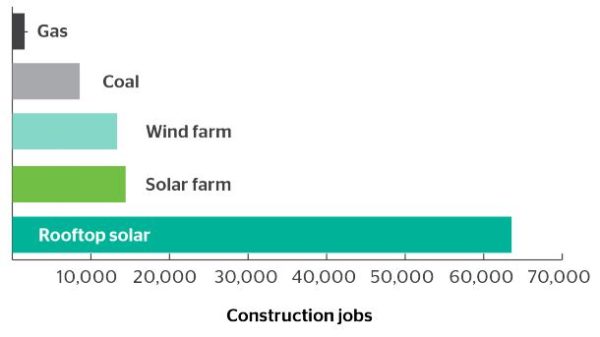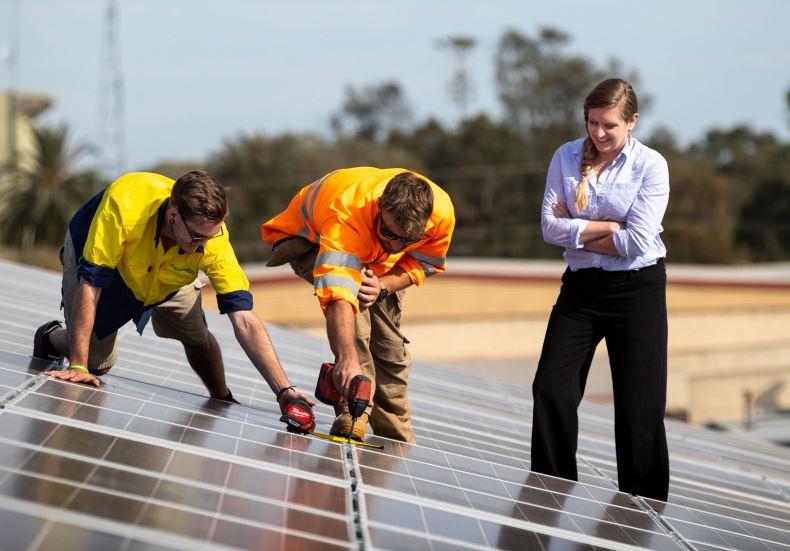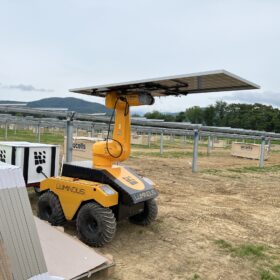When it comes to jobs creation, a new analysis from the Australian Conservation Foundation (ACF) shows renewable energy is the real winner for regional communities that are reliant on coal-fired power stations that are fast approaching their use-by dates.
The analysis, overseen by Green Energy Markets’ director of analysis Tristan Edis, shows that replacing the energy output of the 2,880MW Eraring coal-fired power station, which is scheduled to close in 2025, with renewables would create thousands more construction jobs than replacing it with gas or coal-fired alternatives.
Origin Energy recently announced it is accelerating the shutdown of Australia’s largest coal-fired power station, attributing the early closure to the rapidly changing conditions in the National Electricity Market (NEM), which are “increasingly not well suited to traditional baseload power stations and challenging their viability”.
The Eraring power plant at Lake Macquarie in the Hunter region of New South Wales (NSW) was originally scheduled to close in 2032 but Origin now plans to shut it down in 2025.
Edis said his analysis, using the ‘energy construction jobs tool’ which utilises historical data combined with survey estimates developed by the University of Technology Sydney to provide estimates of the number of jobs created from constructing different power plants relative to their electricity generation, shows replacing the coal-fired power plant with renewables would generate thousands more jobs than replacing it with fossil-fuel alternatives.
The analysis reveals that building enough solar PV farms to replace the 2,880MW black coal plant would create 14,415 jobs, while building wind farms with similar capacity would create 13,339 jobs. Replacing it through the installation of rooftop solar PV would generate an incredible 63,562 jobs.

Image: Green Energy Markets
In contrast, construction jobs for new coal-fired power stations would create just 8,576 roles, while gas plants that made that much power would deliver just 1,566 jobs.
The tool can also be used to provide household comparisons. If Australia chose to power one million homes with new rooftop solar systems, it would create 26,484 construction jobs. The next biggest jobs creator for this task would be solar farms, which would create 6,006 construction jobs. That much power generated by wind farms would create 5,558 jobs while the equivalent power from new coal would create just 3,573 jobs and new gas would create only 652 jobs.
The analysis concludes that a ‘gas-led recovery’ is “not in the best interests of the many thousands of construction workers who are looking to futureproof their income” and that “supply chain jobs associated with the construction of gas plants ranks the lowest in every energy example”.
“Renewable energy is the winning option for communities that have for decades relied on coal-fired power stations which are now on their last legs,” ACF chief executive officer Kelly O’Shanassy said.
“In the Hunter Valley in NSW, the Latrobe Valley in Victoria and Gladstone in Queensland, locals have for many years depended on jobs linked to coal mines and power stations. Replacing old coal-fired generators with renewables will bring a jobs boom to those regions.
“The numbers show replacing the energy output of a coal-fired power station with rooftop solar plus batteries is the best way to create construction jobs, with solar farms second best and wind farms third.
“Replacing old coal with new coal comes a distant fourth in construction jobs, while new gas is the worst creator of energy construction jobs.”

Image: Barnaby Joyce
The findings directly contradict the claims of Deputy Prime Minister Barnaby Joyce, who at the weekend declared that there are “no jobs in the energy transition” and transitioning from coal to cleaner energy “equals unemployment” in the regions.
Speaking on the ABC’s Insiders program, broadcast from Gladstone, Joyce reaffirmed his belief that coal remains critical for Australia’s future.
“If you want to talk about jobs and growth then you need to be talking about coal because that is what our economy has been built on,” he said.
“We are standing by the jobs they’ve got and we’re investing billions towards hydrogen but we’re not going to be saying to people the word ‘transition’ because that equals unemployment.”
O’Shannassy said Joyce was mired in the past, saying the analysis shows that renewable energy is the most beneficial path forward for coal communities.
“Clinging to fossil fuels, makes climate change worse, creates fewer jobs and leads to higher electricity bills. That is not what Australians want,” she said. “Renewables are cheaper, more reliable and create lots of jobs.”
This content is protected by copyright and may not be reused. If you want to cooperate with us and would like to reuse some of our content, please contact: editors@pv-magazine.com.









1 comment
By submitting this form you agree to pv magazine using your data for the purposes of publishing your comment.
Your personal data will only be disclosed or otherwise transmitted to third parties for the purposes of spam filtering or if this is necessary for technical maintenance of the website. Any other transfer to third parties will not take place unless this is justified on the basis of applicable data protection regulations or if pv magazine is legally obliged to do so.
You may revoke this consent at any time with effect for the future, in which case your personal data will be deleted immediately. Otherwise, your data will be deleted if pv magazine has processed your request or the purpose of data storage is fulfilled.
Further information on data privacy can be found in our Data Protection Policy.